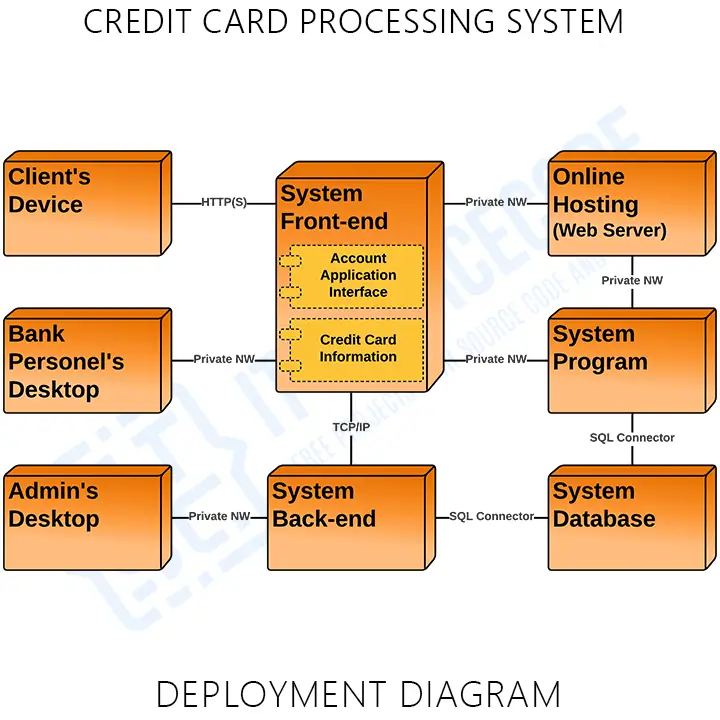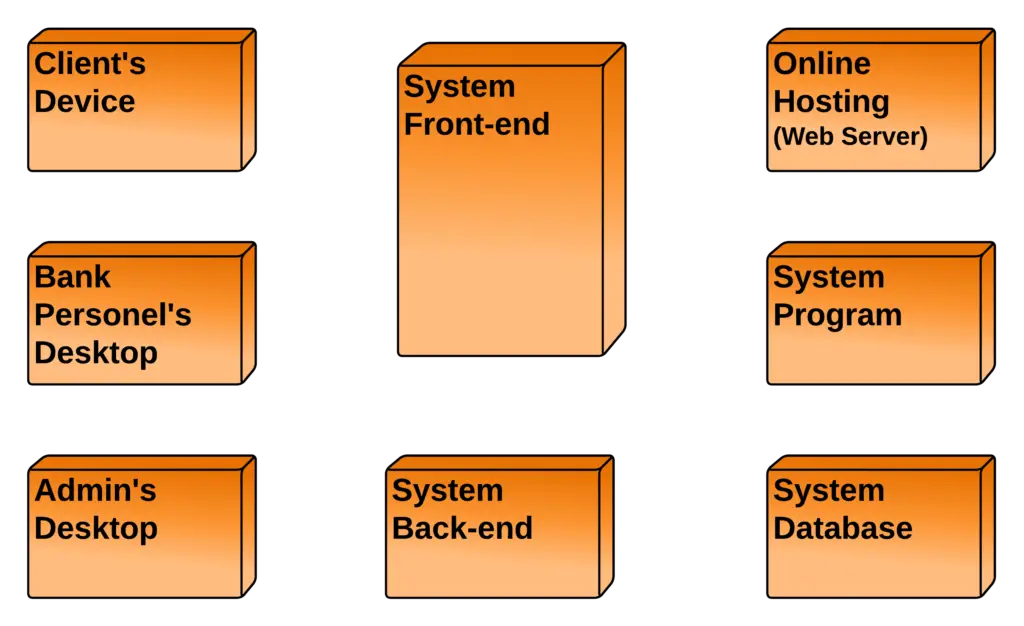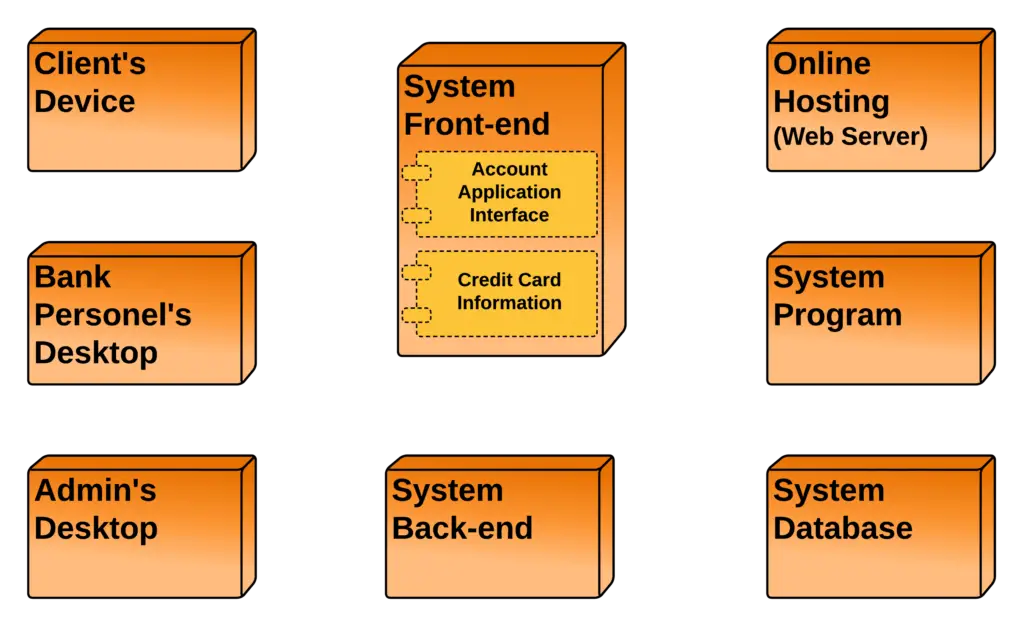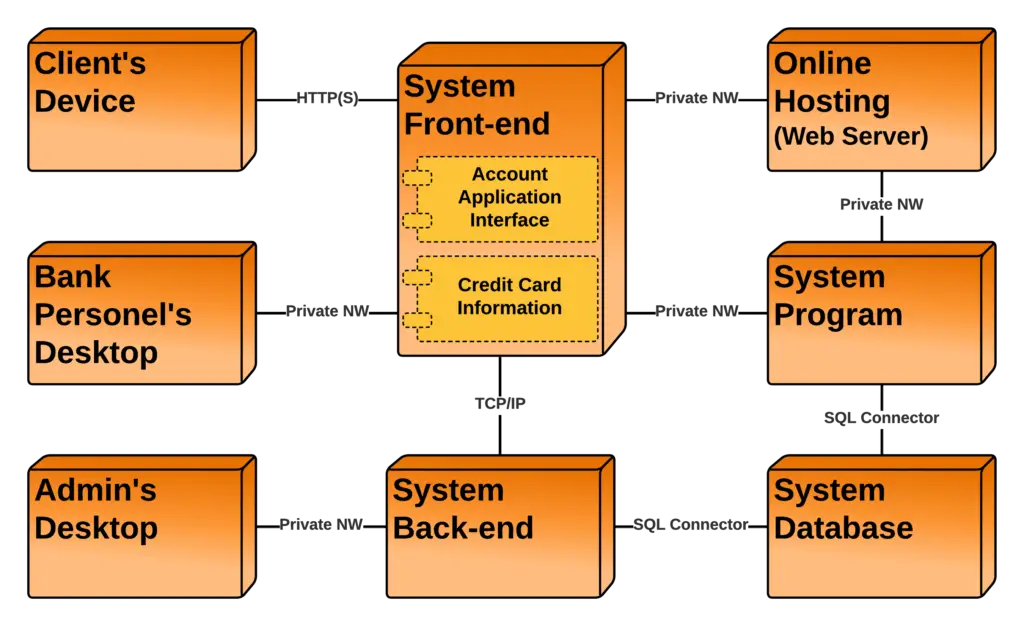What is Credit Card Processing System Deployment Diagram?
A deployment diagram for credit card processing system is used to describe the system’s operation showing the hardware and software components that run in each node, and explaining the connections between them.
Credit Card Processing System Deployment Diagram: Table of contents
- What is Credit Card Processing System Deployment Diagram?
- Deployment Diagram for Credit Card Processing System: Content
- Credit Card Processing System Deployment Diagram Description
- Deployment Diagram for Credit Card Processing System
- Credit Card Processing System UML Deployment Diagram (Explanation)
- Deployment Diagram for Credit Card Processing System (PDF)
- UML Deployment Diagram for Credit Card Processing System
- Steps in Developing Credit Card Processing System Deployment Diagram
- Conclusion:
- Recommended Articles from the Author:
- Inquiries
Deployment Diagram for Credit Card Processing System: Content
The table shows the basic details of the deployment diagram of credit card processing system. It has quick description details of the project.
| Name: | Credit Card Processing System Deployment Diagram |
| Abstract: | The credit card processing system deployment diagram represents the physical structure of the project. It reveals the software and hardware included for the application to work correctly. |
| UML Diagram: | Deployment Diagram |
| Users: | Bank Admin, Crews, Members, and Clients. |
| Tools Used: | Diagraming Tools that have UML Deployment Diagram Symbols |
| Designer: | ITSourceCode.com |
Credit Card Processing System Deployment Diagram Description
Credit card processing is a multi-step process that is required to correctly complete credit card payments. In today’s digital age, transactions can take place in person, online, over the phone, or through the mail. Several entities are involved in credit card processing.
A credit card processing system is software that provides aid in a complicated business with many moving pieces: new technology, payment networks, regulatory authorities, and financial institutions. Credit card processors, like any service involving that level of sophistication, vary in quality.
Deployment Diagram for Credit Card Processing System
The nodes included in the card processing system deployment diagram are represented by boxes. These boxes are labeled as software or hardware that specifies the included components to carry out the credit card processing. The boxes will then be connected and labeled to declare the type of connection they have with the other components.

The core functions of credit card processing are contained in the Credit Card Processing System. This system makes use of server hosting to hold the software and its database.
The function modules are Using the “Process Credit Card” option in the Global menus, payments can be quickly collected from both the Invoice and Accounts Receivable modules. Users are requested to submit credit card information, and a posted Cash Receipt record is created once the transaction is finished.
The system’s job is to allow merchants to deliver batches of approved transactions to their payment processor. The payment processor sends transaction information to the card associations, who then relay the required debits to the network’s issuing banks. The transaction amount is charged to the cardholder’s account by the issuing bank.
Credit Card Processing System UML Deployment Diagram (Explanation)
The Credit Card Processing System UML deployment diagram explains the sketch of the relationship between software and hardware. These hardware and software are labeled to clarify their part in the system’s operation. They were represented by nodes and the connections were represented by labeled arrows.
The deployment diagram shows the scenario when the system is deployed. It has 4 nodes represented with boxes and relationship connections. The nodes are the client’s device, admin’s device, bank personnel’s device, system front-end, back-end, web server, system program, and system database.
For the connection, the system is connected to the server database using a private network which enables it to pass a connection to the devices and enable users to access the system and database. The admin and the customer then can communicate using an online or internet connection.
Deployment Diagram for Credit Card Processing System (PDF)
You may download the Deployment Diagram for Card Processing System PDF by clicking the button below. It has the full details and discussion on System’s Deployment Diagram. You can also modify its content to complete your project requirements and needs.
UML Deployment Diagram for Credit Card Processing System
A deployment diagram for the card processing system in UML is used to illustrate its’ physical architecture. In UML, deployment diagrams can show you how the software and hardware of the learning system work together and where the processing takes place.
The card processing system uses a UML deployment diagram to show how should the developed software be deployed. It clarifies the communications between links(nodes) which helps the project to work according to the design given to it. Deployment diagrams depict the setup of run-time processing nodes and the components that reside on them.
Steps in Developing Credit Card Processing System Deployment Diagram
Time needed: 10 minutes
Here are the steps in developing the credit card system deployment diagram.
- Determine the diagram’s purpose.
To determine the purpose of the deployment diagram, know the description of the credit card system. The purpose of the deployment diagram is to design the needed components (software and hardware) of the system. This is to support and imply the whole processes when credit card processing operates.
- Add the diagram’s nodes.
The term “node” refers to the physical devices that make up the system. Artifacts are deployed on these nodes. Node instances on which artifact instances will be implemented are also possible.

The essential software or hardware elements, or nodes, in the system are represented by the three-dimensional boxes known as nodes. The smaller forms included within the boxes reflect the software artifacts that are distributed, and the lines from node to node indicate relationships. - Add more pieces to the diagram, such as components or artifacts, if needed.
A deployment diagram depicts the locations of components and artifacts in the deployed system. In a software system, artifacts are model elements that reflect physical entities. Executable files, libraries, software components, documents, and databases are examples of physical implementation units.

- Add communication associations.
A communication association (path) is a sort of relationship between nodes in a deployment diagram that indicates how they communicate messages and signals in UML modeling. Deploy relationships in UML show that a certain type of node can be used to deploy a certain type of artifact.

A message or other sort of communication between nodes is indicated by a line called a relation or association.
Additional Knowledge
The topology of the physical components of a system, where the software components are installed, is visualized using deployment diagrams. Deployment diagrams are used to depict a system’s static deployment view. Nodes and their relationships are depicted in deployment diagrams.
The Deployment Model shows how components will be distributed across the system architecture in detail. It contains information about network capabilities, server specifications, hardware requirements, and other aspects of the planned system’s deployment.
Conclusion:
You need to know the diagrams used to design and develop the Credit Card Processing System. That is because you cannot perfectly create a fully-functional system without it. But if you create this deployment diagram, you will know the software and hardware components that the project should possess. Not only that, you will find out the needed specifications and connect them to the other UML Diagrams.
The deployment diagram is used to model the system’s physical architecture. It describes the connections of components between software and hardware system. By completing the Diagrams per module or per process, you will easily achieve your desired system. Check out our Related and Recommended Articles for more Learning and Information.
Related Articles:
- Deployment Diagram for Blood Bank Management System
- Deployment Diagram for Restaurant Management System UML
- Deployment Diagram for Car Rental System
- School Management System Deployment Diagram
- Deployment Diagram for Employee Management System
Recommended Articles from the Author:
- Credit Card Processing System Class Diagram
- Credit Card Processing Sequence Diagram
- Use Case Diagram for Credit Card Processing System
- Credit Card Processing System Activity Diagram
Inquiries
If you have inquiries or suggestions about Deployment Diagram for Credit Card Processing System, just leave us your comments below. We would be glad to hear to concerns and suggestions and be part of your learning.
Keep us updated and Good day!




